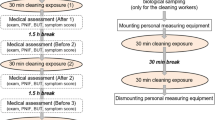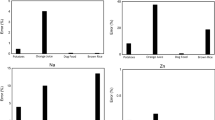Summary
Among 19 workers in a polyurethane foam production plant, visual disturbances (“foggy vision”, “blue haze”, and sometimes halo phenomena) were reported on a total of 47 occasions by five workers over 11 weeks. The symptoms were associated with triethylamine exposure. Time-weighted average levels of 12 to 13 mg/m3 were recorded at work operations associated with symptoms, and 4 to 5 mg/m3 at other tasks. Twice as high peak levels were recorded. A detailed medical examination of the five affected workers in a free interval did not reveal any signs of permanent eye disease.
Similar content being viewed by others
References
American Conference of Governmental Industrial Hygienists (ACGIH) (1984) Threshold Limit Values for Chemical Substances and Physical Agents in the Workroom Environment with Intended Changes for 1983–84, Cincinnati
Amor AJ (1949) The toxicity of solvents. Manuf Chem Manuf Perform 20:540–544
Audunsson G, Mathiasson L (1983) Simultaneous GLC-determination of amines and isocyanates in working atmosphere. J Chromatogr 261:253–264
Belin L, Wass U, Audunsson G, Mathiasson L (1983) Amines: possible causative agents in the development of bronchial hyperreactivity in workers manufacturing polyurethanes from isocyanates. Br J Ind Med 40:251–257
Brieger H, Hodes WA (1951) Toxic effects of exposure to vapors of aliphatic amines. Arch Ind Hyg 3:287–291
Dernehl CV (1966) Health hazards associated with polyurethane foams. J Occup Med 8:59–62
Fregert S (1981) Manual of contact dermatitis, 2nd edn. Munksgaard, Copenhagen
Grant WM (1974) Toxicology of the eye, 2nd edn. Charles C Thomas, Springfield, IL, pp 14–15, 112–113, 701
Hagmar L, Bellander T, Bergöö B, Simonsson BG (1982) Piperazine-induced occupational asthma. J Occup Med 24:193–197
Luckenbach M, Kielar R (1980) Toxic corneal edema from exposure to high atmospheric concentrations of toluene diisocyanates. Am J Ophthalmol 90:682–686
Mastromatteo E (1965) Recent occupational health experiences in Ontario. J Occup Med 7:502–511
Mellerio J, Weale RA (1966) Hazy vision in amine plant operatives. Br J Ind Med 23:153–154
Sangö C (1979) Improved method for determination of traces of isocyanates in working atmosphere by high performance liquid chromatography. J Liq Chromatogr 2:763–774
Swedish National Board of Occupational Safety and Health (1984) Maximum allowable concentrations. Liber, Stockholm (In Swedish)
Åkesson B, Florén I, Skerfving S (1985) Visual disturbances at experimental human exposure to triethylamine. Br J Ind Med 42:848–850
Author information
Authors and Affiliations
Rights and permissions
About this article
Cite this article
Åkesson, B., Bengtsson, M. & Florén, I. Visual disturbances after industrial triethylamine exposure. Int. Arch Occup Environ Heath 57, 297–302 (1986). https://doi.org/10.1007/BF00406184
Received:
Accepted:
Issue Date:
DOI: https://doi.org/10.1007/BF00406184




